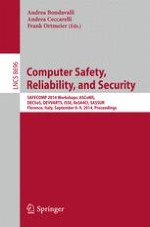This book constitutes the refereed proceedings of 6 workshops co-located with SAFECOMP 2014, the 33rd International Conference on Computer Safety, Reliability, and Security, held in Florence, Italy, in September 2014. The 32 revised full and 10 short papers presented were carefully reviewed and selected from 58 submissions. They are complemented with 6 introduction to each of the workshops: Architecting Safety in Collaborative Mobile Systems, ASCoMS'14; ERCIM/EWICS/ARTEMIS Workshop on Dependable Embedded and Cyberphysical Systems and Systems-of-Systems, DECSoS'14; DEvelopment, Verification and VAlidation of cRiTical Systems, DEVVARTS'14; Integration of Safety and Security Engineering, ISSE'14; Reliability and Security Aspects for Critical Infrastructure Protection, ReSA4CI'14; Next Generation of System Assurance Approaches for Safety-Critical Systems, SASSUR'14.
